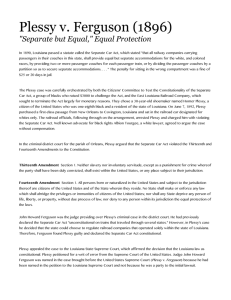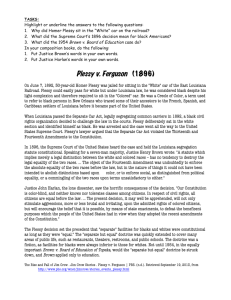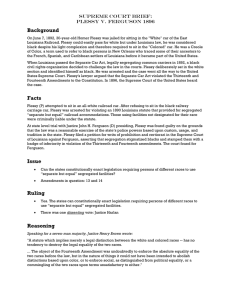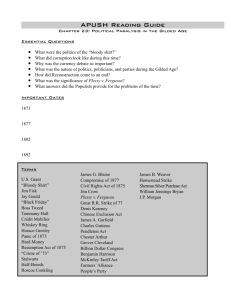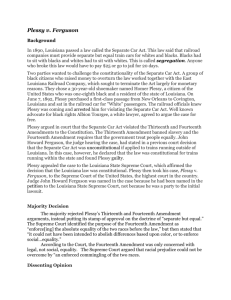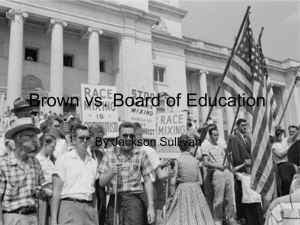Supreme Court Case #5
advertisement
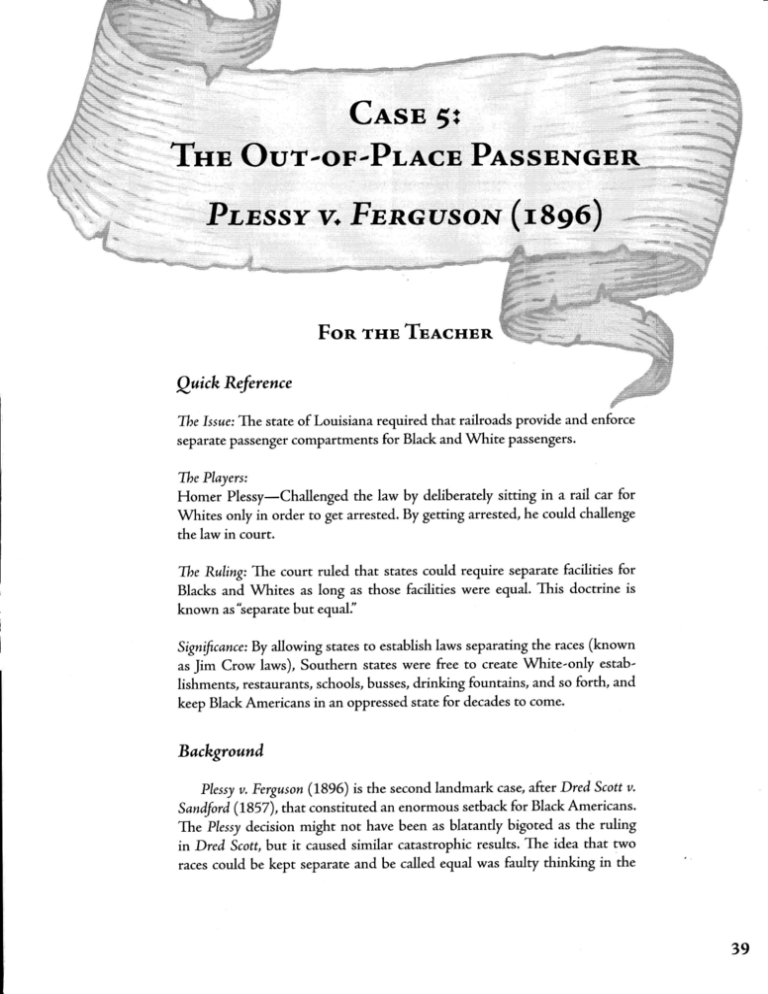
Fon TrrE TsecHBn QuicbReference Tbe Issue: The state of Louisiana required that railroads provide and enforce separate passenger compartmert, fo, Black and White Passengers. Tbe Playerst Homer Plessy-Challenged the law by deliberately sitting in a rail car for Whites only in order to get arrested. By gettingarrested, he could challenge the law in court. Tbe Ruling: The court ruled that states could require separate facilities for Blacks and Whites as long as those facilities were equal. This doctrine is known asieparate but equalJ' Significance: By allowing states to establish laws separating the races (known Jim Crow laws), Southern states were free to create White-only establishments, restaurants, schools, busses, drinking fountains, and so forth, and keep Black Americans in an oppressed state for decades to come. as Background. (1896) is the second landmark case, after Dred Scott v. Sandford (L857),that constituted an enormous setback for Black Americans. Arc Plessy decision might not have been as blatantly bigoted as the ruling in Dred Scott,but it caused similar catastrophic results. The idea that two races could be kept separate and be called equal was fadtl thinking in the Plessy v. Ferguson 39 extreme. Infact, the ruling paved the way forJim Crow laws, that kept Black Americans as second-class citizens for the next 60 years. It wasnt until such rulings Sweatt u. Painter (1950) and Brown v, Board of Education of Topeka * (L954; which will be discussed in detail later in the book), that the walls of legal segregation began to be torn down. Unforrunately, the specter of segregation was not as easily eliminated as changing the law, for segregated communities already were long-established. To try to get those communities together in schools would require more wrenching upheaval in the form of bussing (Sw ann u. Charlotte-Mecklenburg Board of Education, 197 1), 40 SUPREME COURT DECISIONS SscrroNr r Trrs Out-or-Pracn PasseNrcER Donner held his breath as he stepped onto the train, He had prepared for this day for weeks, but he still hoped in his heart that he would not be stopped. He hoped thatjust this one time a man's heritage wouldn't determine where he could live, eat, or even sit on atrain,He walked down the aisle empty handed; ns ltrggage in his hand.It wasnt necessary because he didnt plan on riding the train for long. Jesse looked around at the White faces as he passed through the first car. Interesting he thought, that no one even gave him a second look. Theyd notice him soon enough.Jesse continued to the next passenger car andwas surprised to see it already filling up, only the faces he saw in this cer were Black, although he did not recognize anyone.Jesse stopped, took a deep breath, turned around and walked back toward the frong his heart racing now. WhenJesse entered the White car this time, he drew the attention of several passengers. This time their faces registered the look of annoyance. Some even sighed largebreaths of exasperation. Why did this man have to come back into their cariJesse looked each ofthem in the eye as they stared at him silently. Finally, Jesse stopp ed at an empty aisle seat and abruptly sat down and held his gaze straight ahead, his head held high. Then, the grumbling started, low at first, but it grew louder the longer Jesse stayed seated. He kept his eyes to the front, though, even when some of the passengers reminded him,loudly, that he was in the wrong car.It seemed to Jesse that he sat in that seat for an eternity, but now he was in this and he was not going to move, He also knew that he must not allow his anger to get the better of him. Even if someone became physical with him or assaulted him, he knew that any physical attempt to protect himself would be used against him and would disrupt his plan. He was afraidfor a moment that he would be tested in this regardwhen alarge man grabbed him by the arm, shouting at him with a spitting angry Jesse ' contorted face, : just gritted his ; i \ Jesse teeth and held on to his seat. Luckily, the conductor ran to Jesse's seat and calmed down the man. i Th" train would not | 1" r", he assured the iir: Passengefs, unril this situation was in hand. ,n-j.;pr Supreme :' Court Decisions @ Prufrock Press . This p:Lge may be photocopied or reproduced with permission for classroom use 4l Finally, a transit policeman boarded the train and calmly toldJesse to stand. did what he was told, but did not speak. The policeman put handcuffs on Jesse and led him peacefully from the train. When they stepped onto the loadingpladorm, a man emerged from the crowd and identified himself to the policeman asJesse's lawyer. He followedJesse to the police station, whereJesse was processed and put in jail for breaking the state law that required Black passengers to ride in separate passenger cars from White passengers. Jesse Discussion Questions 1. What are the facts that are pertirlent to this casel 2. What arguments do you predict will be used by each side in the real court casei 3. Why was Jesse so nervous getting on the tain, and why was his lawyer waiting for him to disembarki 4. What is the major question to be decided by this casei 5. You be the judger DidJesse have the right to sit in the Passenger car with the White passengersi 6. How do you think the Supreme Court ruledi 42 Suytreme Court Decisions @ Prufrock Press . This page nty be photocopied or reproduced with permission for classroom use Trrs Acruer, Cass Pmssv rz. FrncusoN (1890) SsctroN 2r In the 1890s, the state of Louisiana passed a law requiring that all passenger trains operating in the state provide"separtte but equal" compartments for Black and White passengers. This could take the form of separate passenger cars or partitions that separated Black and White passengers. In L892, Homer Plessy (who was one-eighth Black) challenged the Separate Car Act, as the law was known, by riding in the Whites-only passenger car of the East Louisiana Railroad Company (Sanson, 1999). Plessy's challenge, however, was not a spur-of-the-moment protest. It had been carcfully orchestrated by a civil rights group with the assistance of the East Louisiana Railroad Company itself. The civil rights group, the Citizens' Committee to Test the Constitutionalicy of the Separate Car Act, planned for Plessyt arrest so that the question would get into the court system. Only then could the case possibly make it to the Supreme Court, where its constirutionaliry could be determined (Sanson, L999). Trrr RurrNc but a Louisiana court, presided over by JudgeJohn Howard Ferguson, ruled that a"separate car" Law was unconstitutional only if the trains were passing through different states. However, the law could apply to trains that stayed within the state of Louisiana. Thus, the law was upheld as constitutional. Plessy appealed the ruling to the Louisiana Supreme Court, where the law again was upheld as constitutional. Finally, Plessy appealed the statet ruling to the U.S' Supreme Court, which heard the case now titled Plessy v. Ferguson (naming the judge in the original case.) In a crushing blow to Plessy and civil rights, the Supreme Court ruled that Louisiana! Separate Car Act was indeed constitutional Plessy was arrested, as planned, 1 (Sanson,1999). a : I : Supreme Court Decisions@ Prufrock p165s . This page rnay be photocopied or reproduced with permission for classroom use 43 The majoriry opinion, written byJustice Henry Brown, stated that the Iaw violated neither the Thirteenth Amendment (prohibiting slavery) nor the Fourteenth Amendment (requiring equal treatment under the law). He wrote, ]* ]i] lE 1g a? The object of the [Fourteenth] amendment was undoubcedly to enforce the absolute equaliry of the two races before the law, but in the nature of things it could not have been intended to abolish ]fr distinctions based upon color, or to enforce social, as distinguished ,i from politic al, eqralky, or a commingling of,the two races upon terms li E 1E I ilj unsatisfactory to either. (Plessy v. Ferguson [1896]) :i Trrs AprpnuATrr The dissenting opinion, written byJusticeJohn MarshallHarlan,predicts with chilling acclrracy the outcome of the Plessy v. Ferguson decisionl What can more certainly arouse race hate, what more certainly cre- ate and perpetuate a feelingof distrust between these races, than state enactments which, in fict,proceed on the ground that colored citizens are so inferior and degraded that they cannot be allowed to sit in public coaches occupied by "Ihe white citizens? (Plessy u. Ferguson [1896]) decision paved the way for states to Pass more laws (known as Jim Crow laws) requiring the separation of races in restaurants, theaters, schools, public ffansportation, and buildings under the banner of "separate but equalJ'It also fanned the fires of ruciil.hatred that created grouPs like the Ku Klux Klan that terrorizedBlack citizens for decades (and still exist to this day). The segregation of Blacks and Whites in America in the 20th century is a dfuectresult of the Supreme Courtt ruling inPlessy u, Ferguson,and was not legally overturned !fldl L954,In practice, however, the walls of segregation Plessy stayed in place for almost 70 years. MarrNc Ir CunnpNr , 44 Have you seen evidence of racid. segregation in your towni Are there neighborhoods that consist almost entfuely of people of one face of anotheri ls there ever a point when the government should step in to change something like thist Supreme Court Decisions @ Prufrock Press . This page m y be photocopied or reproduced with permission for classroom use

